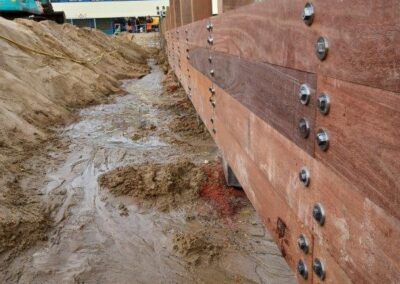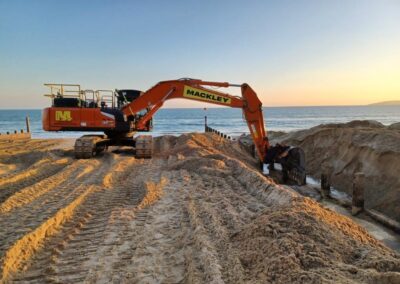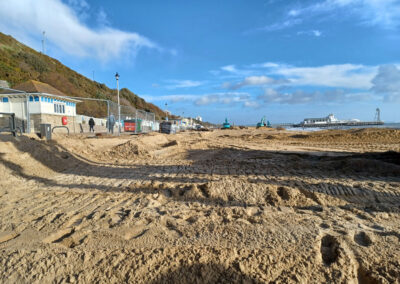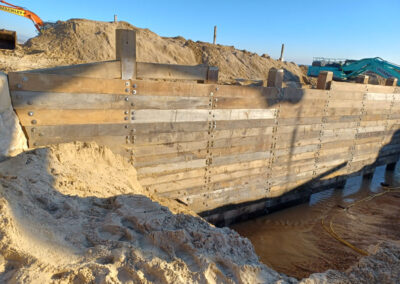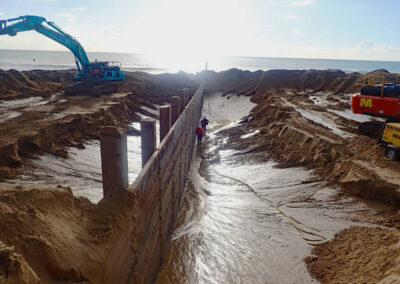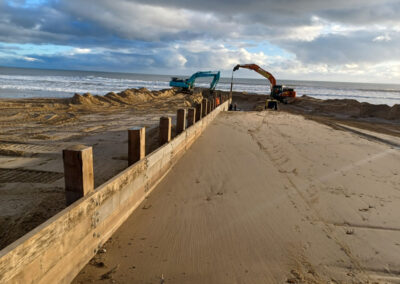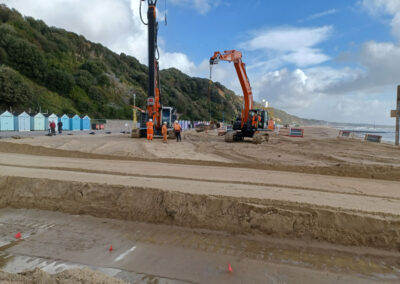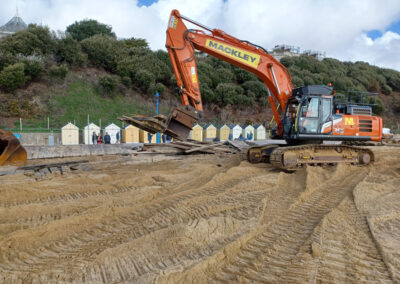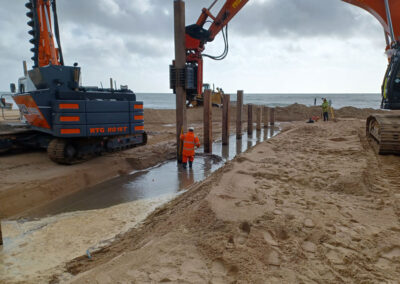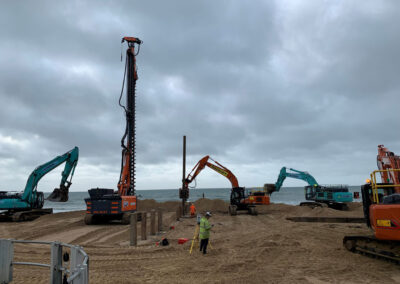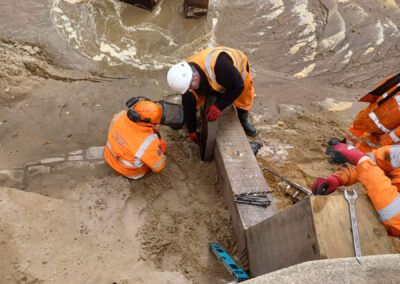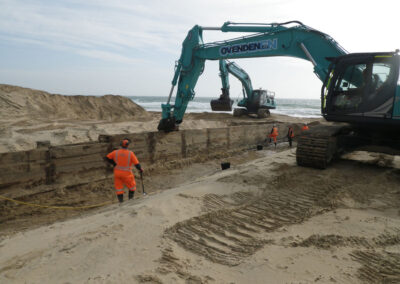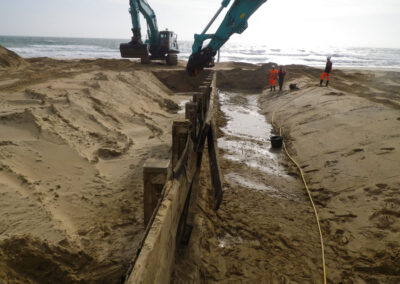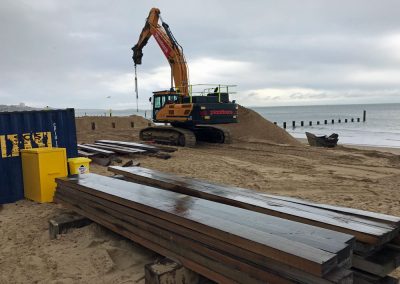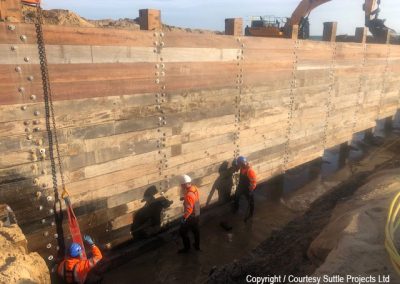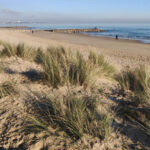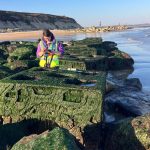Completed Projects
Timber Groyne renewal programme, winter 2022/23
Renewing 4 timber groynes adjacent to Bournemouth Pier
January 2023: works have begun at West Cliff to renew 2 timber groynes (photos below). East Cliff works are due to complete by the end of January.
Christmas & New Year 2022/23
East Cliff timber groyne works will pause over the Christmas period and a smaller fenced area has been created to enable access to the sand. Please continue to follow on site safety signage.
West Cliff timber groyne works are due to commence week beginning 3 January 2023.
December: planking works
November: our contractors, Mackley are making good progress at East Cliff. Piling works were completed in early November, allowing planking to begin
Auger (spiral-shaped drill) arrives on site to install the piles, locations marked by red flags
Auger (spiral-shaped drill) arrives on site to install the piles, locations marked by red flags
Old timber is carefully sorted for recycling & re-use on future BCP projects
Old timber is carefully sorted for recycling & re-use on future BCP projects
Pile installation with the auger and Movax pile driver
Pile installation with the auger and Movax pile driver
A total of 58 piles have been installed for the 2 new groynes at East Cliff
A total of 58 piles have been installed for the 2 new groynes at East Cliff
October: deconstructing the first of four life-expired timber groynes which will be replaced with four new, more evenly spaced ones:
On site safety
Areas of the beach are restricted for safety reasons as the sand becomes very unstable when it is excavated around groynes. Please do not enter or pass the construction zone along the water’s edge, even at low tide. Dogs should be kept on a lead.
Mackley will be on site during normal working hours; however, the teams work with the lowest tides on a rota system, and this may occur outside daylight hours. All works will be in accordance with planning and environmental consents.
The promenade will remain open for the duration of the works but for safety reasons, the length of beach where works are taking place will be fenced off. These areas become temporary construction sites and all beach visitors are asked not to ignore safety signage. Sand can become very unstable when it is excavated around groynes so people should keep out of these zones, even at low tide.
The project is due for completion by end March 2023.
Deconstructing and reconstructing a timber groyne – how it’s done
The planking of a new groyne begins from the top down
The planking of a new groyne begins from the top down
Timber used for the new groynes
Each new groyne will be constructed using a mix of new tropical hardwood timber and recycled tropical hardwood planking, from previously deconstructed timber groynes, when available.
Hardwoods used will be Greenheart - a pale yellow to dark olive green wood from Guyana, South America, and Ekki - a dark red / deep chocolate-brown wood from West Africa and the Congo. These timbers have been selected for their strength, durability and resistance to marine life which can destroy wood by boring into and eating it.
What's eating our timber groynes?
Gribble! These tiny worms (Limnoria terebrans) were first discovered in 1799 and they attack marine timbers. Gribble burrow into groyne timbers, creating long tunnels just beneath the surface; the holes they leave behind eventually weaken the wood, causing it to crumble and rot. This is one of the reasons we renew our groynes every 25 years approx.
Gribble resemble tiny yellowy-pink lice about the size of a grain of rice, but they are actually very small crustaceans. Crustaceans are animals that usually have a hard covering, or exoskeleton, jointed legs and two pairs of antennas, or feelers. Other examples of crustaceans are crabs, lobsters, shrimps, and barnacles.
FUNKY FACTS ABOUT POOLE BAY GROYNES
A total of 29 piles are sunk for a timber groyne, each pile is 10m long and spaced 2.5m apart. The King pile (out at sea) is 12.5m long. Piles are driven down to the first solid layer of stable substrate/clay. Each groyne is between 5m-7.5m deep and roughly 75m in length. Approximately 225 planks of timber make up a groyne. Generally only the top 5 rows are constructed using new timber; recycled timber is used for the bottom 12-14 rows. Timbers unsuitable for re-use on new groynes are recycled for other projects; for example in 2022, for cladding and decking at the Environmental Hub at Durley Chine, and as part of a footbridge created at a flooded wetland scheme in the Tamar Valley AONB, Cornwall.
You'll find more information on projects that reuse BCP groyne timber at our Recycling & Reusing page.
Environmental considerations
All the groyne renewal works will be carried out in accordance with the Marine Management Organisation licence and planning consent. Additionally, new tropical hardwood timber used for this project is certified sustainable by the Forestry Stewardship Council (FSC).
The old groynes will be carefully deconstructed to ensure that all suitable materials can be recovered and recycled or re-used in future coastal projects.
Groynes - their role in coast protection
Beach material generally moves from west to east in Poole Bay. The strategically placed groynes are renewed approximately once every 25 years and slow down the natural processes. Piling and planking deep into the beach to the first solid layer of substrate/clay helps retain the sand within the groyne field.
In combination with periodic beach renourishment (topping-up the beach levels) the groynes also help protect the seawalls and cliffs from erosion. We last renourished some of the beaches from Poole to Southbourne in early 2021 [project details here].
Previous phases of timber groyne renewal:
- Winter 2021/22 – Year 2 of a two-year renewal project, 4 groynes eastwards from Durley Chine to West Cliff zig zag
- Winter 2020/21 – Year 1 of a two-year renewal project, 4 groynes eastwards from Poole/Bournemouth boundary to Middle Chine
- Winter 2017/18 and 2018/19 – 12 groynes at Southbourne
- Winter 2016/17 – 8 groynes eastwards from Fisherman’s Walk to Gordon’s Corner
- Winter 2015/16 – 10 groynes from the east of Boscombe Pier to Fisherman’s Walk



